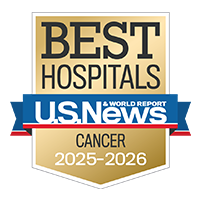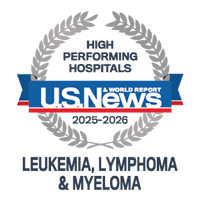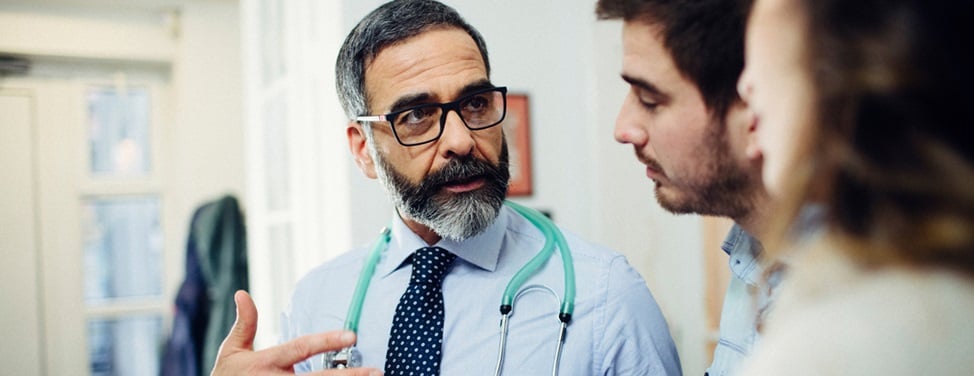Leukemia

Overview
What is leukemia?
Leukemia is a term for certain cancers of the blood. These disorders start in blood-forming tissues in the bone marrow or lymphatic system (tissues and organs that work to prevent or resolve disease), and they usually involve white blood cells, which are key players in fighting infection. In leukemia, there's an overproduction of abnormal white blood cells. The abnormal cells don't function properly, impairing your ability to combat infection and affecting the other types of blood cells that your body needs to stay healthy.
There are several types of leukemia – some more common than others. The type is defined by which specific cells are impacted and the speed at which they multiply.
Leukemia most often occurs in adults over 55. It's also the most common cancer in children under 15.
Our approach to leukemia
UCSF is dedicated to delivering the most advanced treatment options for leukemia with care and compassion. We perform extensive evaluations that help us determine the best course of treatment for each patient. The plan may include chemotherapy, radiation therapy, immunotherapy, (treatments that help the patient's immune system fight their cancer) or stem cell transplantation. During treatment, our highly skilled team provides intensive supportive care to address side effects and protect patients from infection.
In addition to patient care, we are dedicated to discovering better treatments through research. Interested patients may have opportunities to participate in clinical trials for leukemia treatment. Learn more about the process and benefits of participating in a clinical trial.
Awards & recognition
-

Among the top hospitals in the nation
-

Best in California and No. 7 in the nation for cancer care
-

Rated high-performing hospital for leukemia, lymphoma & myeloma care
Causes of leukemia
Scientists believe that both genetic and environmental factors play roles in the development of leukemia, but a precise cause has not been found.
Leukemia occurs when a change (mutation) in the genetic material (DNA) of white blood cells causes them to grow uncontrollably. These abnormal cells can't fight infection properly. And as they increase in number, they crowd out the red blood cells, which are necessary to carry oxygen throughout the body, and platelets, which are needed to stop bleeding by helping blood clot.
Risk factors for leukemia may include:
- Smoking
- Radiation exposure
- Exposure to certain toxins
- A family history of leukemia
Types of leukemia
All leukemias originate in the bone marrow and lymphatic tissues that make blood cells, which then move into the circulatory system. Different leukemias are distinguished by the kind of blood cell affected and how fast the cancer progresses.
Chronic leukemias develop slowly and symptoms may not be present or obvious in early stages. Acute leukemias grow more aggressively and symptoms can appear suddenly.
There are four main types of leukemia:
- Acute lymphoblastic leukemia (ALL). In ALL, the bone marrow overproduces white blood cells called lymphocytes. Both adults and children can get ALL, and it may progress quickly. It's the most common cancer in children under 4.
- Acute myeloid leukemia (AML). Also called acute myelogenous leukemia, AML occurs in white blood cells called myeloid cells. Both adults and children can get AML, and it can spread quickly if not treated promptly.
- Chronic lymphocytic leukemia (CLL). CLL affects mature B cells, the immune system cells that create antibodies, which are crucial in fighting disease. This is the most common type of leukemia in older adults. It rarely affects children.
- Chronic myeloid leukemia (CML). Also called chronic myelogenous leukemia, CML affects the myeloid immune cells, but unlike AML, it progresses slowly. It's more common in older adults and rare in children.
Symptoms of leukemia
Signs of leukemia vary depending on the type and may be mistaken for symptoms of other conditions, such as the flu. Leukemia symptoms may include:
- Bruising or bleeding easily
- Fever or night sweats
- Frequent nosebleeds
- Loss of appetite
- Pain or a full feeling under the ribs
- Depending on original skin color, paleness or grayish skin tone
- Persistent infections
- Swollen lymph nodes
- Tiny red spots on the skin (petechiae)
- Unexplained weight loss
- Weakness or fatigue
In acute leukemias, symptoms may develop rapidly (in a matter of weeks), whereas chronic leukemias develop slowly and health problems may not appear for years. Chronic myeloid leukemia (CML) develops so gradually that some people don't experience any symptoms.
Diagnosis of leukemia
Different tests are used to diagnose leukemia. The tests your doctor selects will depend on your symptoms, possible risk factors, and the type of leukemia your symptoms and history suggest. Frequently used tests include:
- Medical history and physical exam. The doctor will ask questions to learn about your family history and general health. They'll also look for signs of leukemia in your body, for example, by checking for swollen lymph nodes.
- Blood tests. The laboratory will analyze samples of your blood in various ways. This will likely include counting your red cells, white cells and platelets, and analyzing them for abnormalities.
- Bone marrow aspiration and bone marrow biopsy. These are methods of using a needle to obtain bone marrow samples to be examined for signs of disease. The aspiration takes a sample of liquid marrow while the biopsy takes a sample of the marrow's soft tissue. The procedures are similar and often done at the same time.
- Lymph node biopsy. This involves removing tissue from a lymph node and examining it under a microscope for cancer cells.
You might have imaging tests as well, such as X-rays, an MRI, a CT scan or an ultrasound, to determine whether the cancer has spread beyond the blood to other parts of your body. Your doctor may also recommend a cerebrospinal fluid (CSF) collection. Also called a spinal tap, a CSF collection is performed to examine the fluid surrounding the brain and spinal cord; this can show whether the cancer has spread to your nervous system.
Treatment of leukemia
Treatments vary significantly depending on the leukemia type and severity. However, certain treatments are commonly used for all types.
Chemotherapy for leukemia
Chemotherapy involves medications that kill cancer cells. The drugs may be taken by mouth or administered intravenously (into a vein). The selection of drugs depends on the specific cancer.
Radiation therapy for leukemia
Radiation therapy uses high-energy radiation to kill cancer cells. The radiation dose and treatment duration depend on the type and severity of the cancer.
Targeted drug therapy for leukemia
Targeted drugs precisely identify and attack certain cancer cells, minimizing the harm to healthy cells. Because they work differently from standard chemotherapy drugs, they may be used when those drugs aren't working or to boost a chemotherapy treatment. Examples of targeted drug therapies include monoclonal antibodies, tyrosine kinase inhibitors (TKIs) and CAR (chimeric antigen receptor) T-cell therapy.
Immunotherapy for leukemia
Immunotherapy drugs stimulate your immune system so it can better identify and fight cancer cells. Immunotherapy isn't typically used on its own to treat leukemia. It's usually combined with other treatments, such as radiation, chemotherapy and surgery.
Stem cell transplant for leukemia
A stem cell transplant replaces the bone marrow's abnormal blood-forming cells (the ones producing cancer cells) with new healthy ones.
There are two main types of stem cell transplants:
- Autologous stem cell transplant. This uses the patient's own stem cells. Before the procedure, the cells are taken from the bone marrow and treated to remove the cancerous cells.
- Allogeneic stem cell transplant. The patient receives stem cells from a matched donor; this is often a close relative but may also be a stranger. (Matching means that certain proteins on the cells' surfaces are compatible.) Because this method is riskier that an autologous transplant, with potentially severe side effects, it isn't always suitable for older patients or people with other health problems.
Before a transplant is done, patients undergo radiation or high-dose chemotherapy to destroy any remaining cancer cells and make room in the bone marrow for the transplanted stem cells. If the transplant is successful, the new stem cells start to multiply and produce healthy blood-forming cells.
This information is for educational purposes only and is not intended to replace the advice of your doctor or other health care provider. We encourage you to discuss any questions or concerns you may have with your provider.































